
Concept explainers
(a)
Interpretation: The solubility of minoxidil in acidic and basic aqueous solution should be determined.
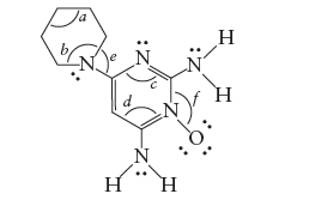
Concept Introduction: The Lewis structure of an organic compound represents the bonding of atoms with lone pairs (if any). It indicates the bonds with atoms and also arrangement of atoms in molecule.
Hybridization of any atom indicates the molecular geometry of molecule. The formula to check the hybridization can be written as:
Hybridization = Number of sigma bonds + Number of lone pair
(a)
Answer to Problem 40E
Minoxidil must be soluble in acidic aqueous solution.
Explanation of Solution
Minoxidil contains two −NH2 groups. The
As in acidic solution, it will form salt and therefore will be soluble.
(b)
Interpretation: The hybridization of five nitrogen atoms in minoxidil should be determined.
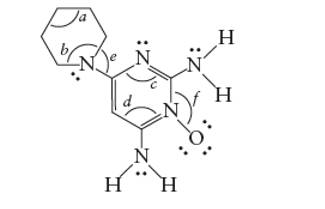
Concept Introduction: The Lewis structure of an organic compound represents the bonding of atoms with lone pairs (if any). It indicates the bonds with atoms and also arrangement of atoms in molecule.
Hybridization of any atom indicates the molecular geometry of molecule. The formula to check the hybridization can be written as:
Hybridization = Number of sigma bonds + Number of lone pair
(b)
Answer to Problem 40E
Explanation of Solution
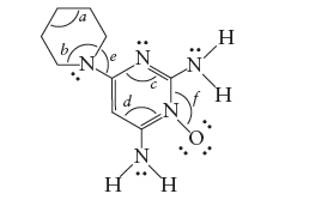
Minoxidil contains two −NH2 groups. There are three N atoms in the ring. Thus the hybridization of N atoms are:
(c)
Interpretation: The hybridization of each carbon atoms in minoxidil should be determined.

Concept Introduction: The Lewis structure of an organic compound represents the bonding of atoms with lone pairs (if any). It indicates the bonds with atoms and also arrangement of atoms in molecule.
Hybridization of any atom indicates the molecular geometry of molecule. The formula to check the hybridization can be written as:
Hybridization = Number of sigma bonds + Number of lone pair
(c)
Answer to Problem 40E
Explanation of Solution
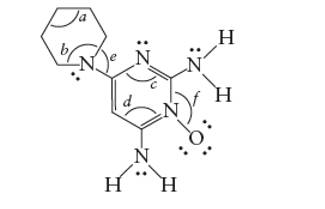
Minoxidil contains two types of C atoms. The double bonded carbon atoms are part of one ring whereas another ring contains only single bonded C atom.
(d)
Interpretation: The bond angles marked as a, b, c, d, e and f in the given molecule of minoxidil should be determined.
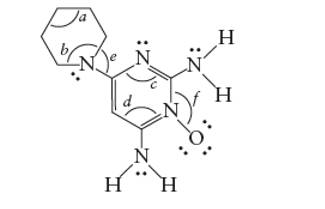
Concept Introduction: The Lewis structure of an organic compound represents the bonding of atoms with lone pairs (if any). It indicates the bonds with atoms and also arrangement of atoms in molecule.
Hybridization of any atom indicates the molecular geometry of molecule. The formula to check the hybridization can be written as:
Hybridization = Number of sigma bonds + Number of lone pair
(d)
Answer to Problem 40E
- 109°
- 109°
- 120°
- 120°
- 109°
- 120°
Explanation of Solution
The hybridization of bonded atoms determines the bond angle.
A sp3 hybrid C atom has 109° bond angle with tetrahedral geometry whereas a sp2 hybrid C atom has 120 ° bond angle with trigonal planer geometry. Similarly the single bonded N atom has 109° bond angle whereas a double bonded N atom has 120° bond angle. Thus, the marked bond angles must be:
- 109°
- 109°
- 120°
- 120°
- 109°
- 120°
Interpretation: Interpret the number of sigma bonds in the given molecule including hydrogen atoms.

Concept Introduction: The Lewis structure of an organic compound represents the bonding of atoms with lone pairs (if any). It indicates the bonds with atoms and also arrangement of atoms in molecule.
Hybridization of any atom indicates the molecular geometry of molecule. The formula to check the hybridization can be written as:
Hybridization = Number of sigma bonds + Number of lone pair
Answer to Problem 40E
There are total 30 sigma bonds in the molecule.
Explanation of Solution
A single covalent bond is formed by one sigma bond whereas one double bond is composed of one sigma bond and one pi bond.
Each C atom must be bonded with four other atoms. Therefore in the bond line formula, each C atom must be bonded with other C or N atom and the tetravalency will be completed with H atoms.
Thus there are total 30 sigma bonds in the given molecule.
(f)
Interpretation: Interpret the number of p-bonds in the given molecule.
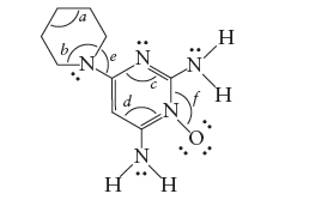
Concept Introduction: The Lewis structure of an organic compound represents the bonding of atoms with lone pairs (if any). It indicates the bonds with atoms and also arrangement of atoms in molecule.
Hybridization of any atom indicates the molecular geometry of molecule. The formula to check the hybridization can be written as:
Hybridization = Number of sigma bonds + Number of lone pair
(f)
Answer to Problem 40E
There are total 3 p-bonds in the molecule.
Explanation of Solution
A single covalent bond is formed by one sigma bond whereas one double bond is composed of one sigma bond and one pi bond.
Each C atom must be bonded with four other atoms. Therefore, in the bond line formula, each C atom must be bonded with other C or N atom and the tetravalency will be completed with H atoms.
Thus, there are total 3 p-bonds in the given molecule.
Want to see more full solutions like this?
Chapter 21 Solutions
Chemical Principles
- A student proposes the transformation below in one step of an organic synthesis. There may be one or more reactants missing from the left-hand side, but there are no products missing from the right-hand side. There may also be catalysts, small inorganic reagents, and other important reaction conditions missing from the arrow. • Is the student's transformation possible? If not, check the box under the drawing area. . If the student's transformation is possible, then complete the reaction by adding any missing reactants to the left-hand side, and adding required catalysts, inorganic reagents, or other important reaction conditions above and below the arrow. • You do not need to balance the reaction, but be sure every important organic reactant or product is shown. + T X O O лет-ле HO OH HO OH This transformation can't be done in one step.arrow_forwardDetermine the structures of the missing organic molecules in the following reaction: X+H₂O H* H+ Y OH OH Note: Molecules that share the same letter have the exact same structure. In the drawing area below, draw the skeletal ("line") structures of the missing organic molecules X and Y. You may draw the structures in any arrangement that you like, so long as they aren't touching. Click and drag to start drawing a structure. X Sarrow_forwardPredict the major products of this organic reaction. If there aren't any products, because nothing will happen, check the box under the drawing area instead. No reaction. HO. O :☐ + G Na O.H Click and drag to start drawing a structure. XS xs H₂Oarrow_forward
- What are the angles a and b in the actual molecule of which this is a Lewis structure? H H C H- a -H b H Note for advanced students: give the ideal angles, and don't worry about small differences from the ideal groups may have slightly different sizes. a = b = 0 °arrow_forwardWhat are the angles a and b in the actual molecule of which this is a Lewis structure? :0: HCOH a Note for advanced students: give the ideal angles, and don't worry about small differences from the ideal that might be caused by the fact that different electron groups may have slightly different sizes. a = 0 b=0° Sarrow_forwardDetermine the structures of the missing organic molecules in the following reaction: + H₂O +H OH O OH +H OH X Note: Molecules that share the same letter have the exact same structure. In the drawing area below, draw the skeletal ("line") structure of the missing organic molecule X. Click and drag to start drawing a structure.arrow_forward
- Identify the missing organic reactant in the following reaction: x + x O OH H* + ☑- X H+ O O Х Note: This chemical equation only focuses on the important organic molecules in the reaction. Additional inorganic or small-molecule reactants or products (like H₂O) are not shown. In the drawing area below, draw the skeletal ("line") structure of the missing organic reactant X. Click and drag to start drawing a structure. Carrow_forwardCH3O OH OH O hemiacetal O acetal O neither O 0 O hemiacetal acetal neither OH hemiacetal O acetal O neither CH2 O-CH2-CH3 CH3-C-OH O hemiacetal O acetal CH3-CH2-CH2-0-c-O-CH2-CH2-CH3 O neither HO-CH2 ? 000 Ar Barrow_forwardWhat would be the best choices for the missing reagents 1 and 3 in this synthesis? 1. PPh3 2 2. n-BuLi 3 Draw the missing reagents in the drawing area below. You can draw them in any arrangement you like. • Do not draw the missing reagent 2. If you draw 1 correctly, we'll know what it is. • Note: if one of your reagents needs to contain a halogen, use bromine. Explanation Check Click and drag to start drawing a structure.arrow_forward
- Predict the products of this organic reaction: NaBH3CN + NH2 ? H+ Click and drag to start drawing a structure. ×arrow_forwardPredict the organic products that form in the reaction below: + OH +H H+ ➤ ☑ X - Y Note: You may assume you have an excess of either reactant if the reaction requires more than one of those molecules to form the products. In the drawing area below, draw the skeletal ("line") structures of the missing organic products X and Y. You may draw the structures in any arrangement that you like, so long as they aren't touching. Click and drag to start drawing a structure. Garrow_forwardPredict the organic products that form in the reaction below: OH H+ H+ + ☑ Y Note: You may assume you have an excess of either reactant if the reaction requires more than one of those molecules to form the products. In the drawing area below, draw the skeletal ("line") structures of the missing organic products X and Y. You may draw the structures in any arrangement that you like, so long as they aren't touching. Click and drag to start drawing a structure. ✓ marrow_forward
 Chemistry & Chemical ReactivityChemistryISBN:9781337399074Author:John C. Kotz, Paul M. Treichel, John Townsend, David TreichelPublisher:Cengage Learning
Chemistry & Chemical ReactivityChemistryISBN:9781337399074Author:John C. Kotz, Paul M. Treichel, John Townsend, David TreichelPublisher:Cengage Learning Chemistry & Chemical ReactivityChemistryISBN:9781133949640Author:John C. Kotz, Paul M. Treichel, John Townsend, David TreichelPublisher:Cengage Learning
Chemistry & Chemical ReactivityChemistryISBN:9781133949640Author:John C. Kotz, Paul M. Treichel, John Townsend, David TreichelPublisher:Cengage Learning Chemistry by OpenStax (2015-05-04)ChemistryISBN:9781938168390Author:Klaus Theopold, Richard H Langley, Paul Flowers, William R. Robinson, Mark BlaserPublisher:OpenStax
Chemistry by OpenStax (2015-05-04)ChemistryISBN:9781938168390Author:Klaus Theopold, Richard H Langley, Paul Flowers, William R. Robinson, Mark BlaserPublisher:OpenStax Chemistry: The Molecular ScienceChemistryISBN:9781285199047Author:John W. Moore, Conrad L. StanitskiPublisher:Cengage Learning
Chemistry: The Molecular ScienceChemistryISBN:9781285199047Author:John W. Moore, Conrad L. StanitskiPublisher:Cengage Learning
 ChemistryChemistryISBN:9781305957404Author:Steven S. Zumdahl, Susan A. Zumdahl, Donald J. DeCostePublisher:Cengage Learning
ChemistryChemistryISBN:9781305957404Author:Steven S. Zumdahl, Susan A. Zumdahl, Donald J. DeCostePublisher:Cengage Learning





